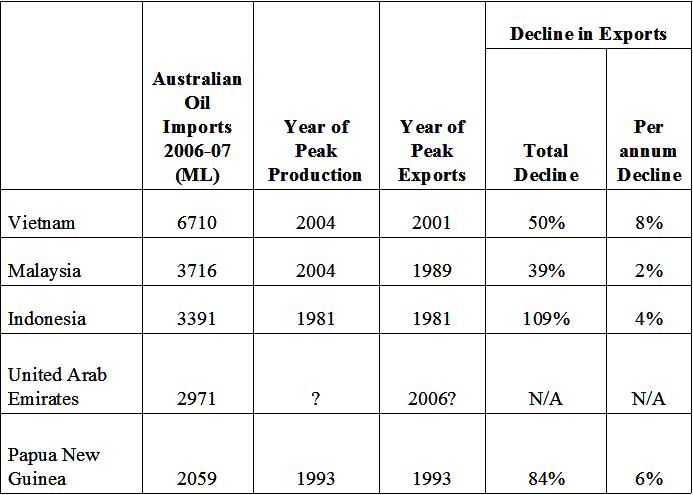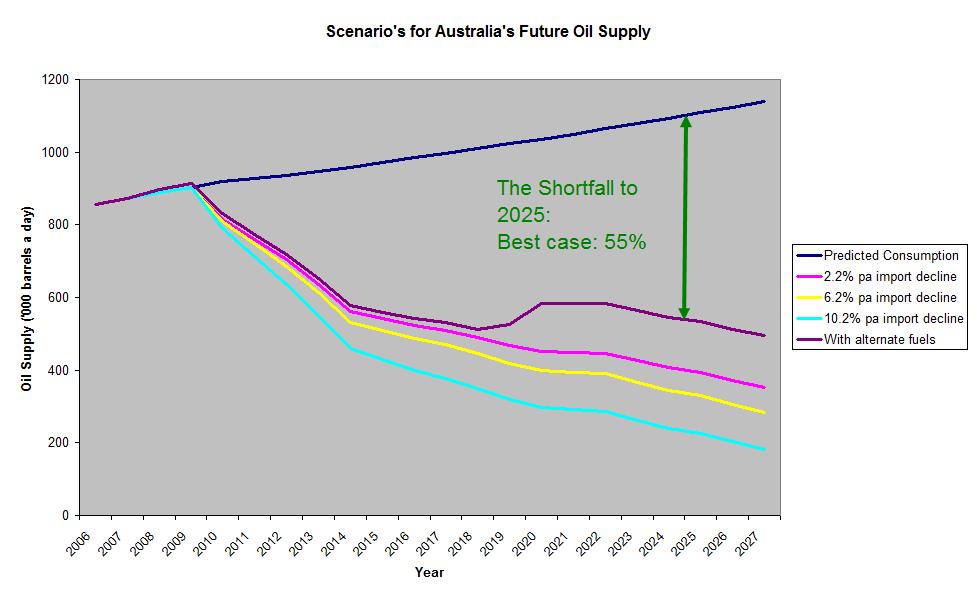
Table One: export situation of top five countries that Australia imports oil from. All data sourced from here.
Advertisement
Two oil analysts who have been investigating declining oil exports suggest that the average rate of decline in oil exports from the top five oil exporters will be 6.2 per cent +/- 4 per cent per annum. With demand for oil imports growing, this situation will likely result in demand destruction, higher oil prices and physical shortages.
Australia’s oil supply consists of our domestic oil production and oil imports. Combining Geoscience Australia’s prediction for future Australian oil production with imports declining at 6.2 per cent +/- 4 per cent per annum provides three indications of Australia’s future oil supply, as shown in chart three. There are a number of assumptions used in developing this model, they are:
Australia imports limited oil from the world’s top five oil exporters. However the production from large oil producing regions declines at a slower rate than smaller oil producing regions. Therefore applying the 6.2 per cent +/- 4 per cent pa decline rates is likely to be a more optimistic decline rate than that which will apply to Australia’s major oil providers. This is further supported by the annual percentage declines in exports from Australia’s major oil providers shown in table one.
That Australia can import its current percentage of the world’s declining oil export base. There is and will continue to be intense competition from all oil importing nations for the declining world oil export base. This includes the majority of OECD nations and rising powers such as China and India. Maintaining this percentage will be a very difficult task to achieve.
The model does not account for geopolitical factors that could reduce oil available for export. Examples of such factors include civil unrest in oil exporting nations, war, bilateral arrangements, such as those recently signed between Russia and China, and exporters deciding to produce less oil in order to maximise their profits and save oil wealth for future generations, as Saudi Arabia is doing.
Does not include alternative fuels. However according to the Commonwealth Government’s National Energy Security Assessment, these are unlikely to be more than niche fuels out to 2023 (the latest forecast prediction) and therefore are unlikely to make more than a minor contribution to Australia’s fuel supply.
Advertisement
Does not consider the cost of oil. It is likely that the oil will become increasingly volatile and costly, continuing the trend of the last five years. Indeed there have been numerous comments from the International Energy Agency and other organisations warning that the current oil price and reduction in credit as a result of the global financial crisis will result in another oil price spike when demand for oil recovers.
It only considers the net difference between consumption and domestic production. Australia exports a large percentage of its oil production due to a combination of the location of its oil fields and the grades of oil they produce. Australian refineries are optimised for different grades of oil, therefore our dependence on imported oil is actually higher than that indicated in chart one.

Discuss in our Forums
See what other readers are saying about this article!
Click here to read & post comments.
40 posts so far.